| This is from the July 1978 Sport Aviation.
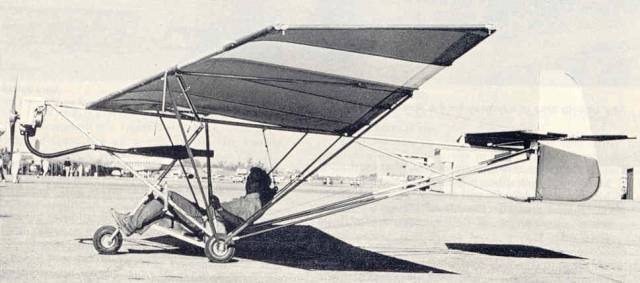
John Chotia and the Weedhopper at Chino '78
The Weedhopper
By John F. Chotia (EAA 125461)
President
Ultra Systems, Inc.
Box 2253 1965 S. 1100 W.
Ogden, UT 84404
The WEEDHOPPER is my 23rd ultra-light design. Over the last 12 years I
have built 18 hang gliders of both rigid wing and flex-wing types; the
other 5 were powered ultralights, some foot launched and others wheel
launched. All of these planes went through several configuration
changes, so all together over 50 aerodynamic concepts have been tried.
The goal has always been a low cost, fun, safe airplane. The pure
hang gliders were certainly fun but lacked convenience and safety. I
concluded that hang gliders are okay for young, single types with the
time to chase the weather, but for me with 4 children and a wife, flying
time is limited so I didn't want to spend it traveling and waiting for
the wind. Foot launching lends itself to scrapes and bruises, too, and I
was getting tired of that.
I tried foot launched powered hang gliders but I was near 200 lbs. so
I still needed a hill and wind. This led me to a rolling launch and
aircraft status. (It interesting to note that I've found the FAA much
easier to work with than some of the very political hang gliding clubs
which control flying sites!)
This slow reinvention of the airplane has allowed me to re-evaluate
just how much structural complexity was necessary. The Weedhopper is the
final result. I could have made it perhaps 15% lighter, but construction
time would have been easily 10 times as great and the plane would have
not been nearly as rugged. A 15% savings is only 24 lbs. anyway. I found
it very easy to add pieces to achieve a particular function, but much
more difficult to simplify while retaining all the functions I consider
necessary for safe, convenient, fun flying.
The final design (Weedhopper) came down to the following:
- It must be powered to be independent of wind and hills.
- The wing structure must be rigid to retain stability,
controllability and safety in all attitudes (even inverted).
- There must be aerodynamic control of at least pitch and yaw;
dihedral has proven adequate when combined with rudder for roll
control when airborne.
- The plane must be capable of lifting a "mature male", i.e., 220
lbs., at field elevations of at least 5000 ASL.
- Wheels are needed to allow less-than-athletes (soft old men) to
fly in safety.
- Ground handling must be easy and convenient; to me this meant
tricycle gear with a steerable nose wheel.
- Since there are no ailerons, the landing gear must be very
stable. The Weedhopper's main gear is 4' 4" wide and the pilot sits
only 6" off the runway.
- The structure must be simple, low-cost and rugged.
- It must be easily portable and only require one man to set up.
- Oh, yes, It must be attractive! Everyone has an ego to deal
with!
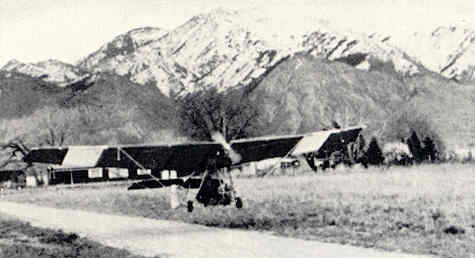
Any smooth area is a runway for the Weedhopper
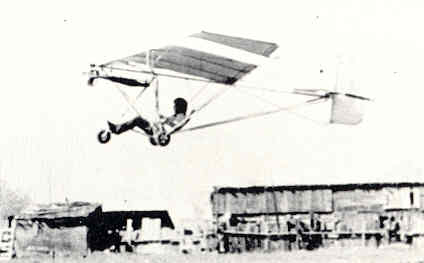
Earlier "short nose" version of the Weedhopper in flight
The Weedhopper meets these goals and then some. The tractor engine
choice allows the empty plane to balance at the proper point to fly so
the pilot's seat can be located directly on the C.G. Weight and balance
tests with various pilots show about 1/2" max. contrast to most
pusher-type ultra-lights which are very sensitive to pilot weight
changes. This feature allows several people to fly the same plane
without worrying about stability or trim. The central pilot forward
engine arrangement is safer in the event of a crash since you don't have
a screamin' 5000 rpm engine out back waiting to punch through the
pilot's back and the pilot is protected at least a little by the
surrounding structure. The central pilot position also lends a feeling
of security because the pilot is more In the plane than perched on it;
he has better attitude reference, too.
The wide, low landing gear handles crosswinds better than I hoped
for. Take-offs and landings have been made in up to 10 mph winds 900 to
the runway. Just keep the nose wheel down until take-off speed is
reached and don't get caught halfway between rolling and flying.
Landings have been made at crab angles approaching 45� (on grass) and
the plane just plops down and straightens itself out.
The Weedhopper has been flown in moderate turbulence and handles it
quite well, the only problem being low speed and high drag. This allows
sudden gusts to sap your momentum so you need to use more power.
Attitude control and auto-stability are very good and the rudder is as
effective as ailerons in leveling the wings, if needed. Most often the
pilot must correct pitch to avoid ballooning in gusts. Flying in gusty
winds is not recommended, however, since at low altitudes the space
needed to correct could be greater than the space available, especially
during turns, but if the wind comes up during a flight, the best method
to get down is a straight in, fast approach and fly it onto the runway.
Also with a 30 mph cruise you might be surprised at how little headway
you can make into a 25 mph wind; you could walk faster.
Stalls in straight flight and shallow banks aren't unusual except
that only about 25-30 ft. is lost, power off and slightly less power on.
With the small high speed propeller, torque isn't much of a factor. When
stalled at moderate to steep banks, the inside wing drops. I've never
allowed it to spin beyond V4 turn but the recovery is rapid and normal.
The altitude lost in such a wing-drop-recover maneuver is about 50 ft.,
sometimes less.
The Weedhopper has flown with adequate performance with a 220 lb.
load at 4500 ft. ASL on its single surfaced wing and direct drive 19 hp
engine, but there are add on options, such as a double surfaced sail and
streamlined struts which are recommended for pilots over 190 lbs. who
plan to fly at altitudes over 4000 ft. These will be especially
important on warmer days. I feel that a plane isn't fun to fly if the
performance becomes marginal even once in a while.
I feel that the Weedhopper really opens a new area of recreational
flying. It is low cost, yet still safe, functional and not under-powered
or difficult to fly. Ultra Systems was incorporated early this year to
promote and produce the Weedhopper. I had personally carried the cost
and effort of development over the last 12 years with just the help of
my wife and a few friends. Now Ultra Systems, Inc. has the capital and
facility to do a proper job of marketing my dream. For me it is a dream
come true, one I hope many other people can now share.
Further information is available from Ultra Systems, Inc.,P; O. Box
2253, Ogden, UT 84404.
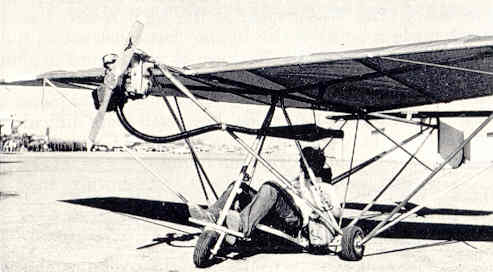
Er ... "cockpit" details
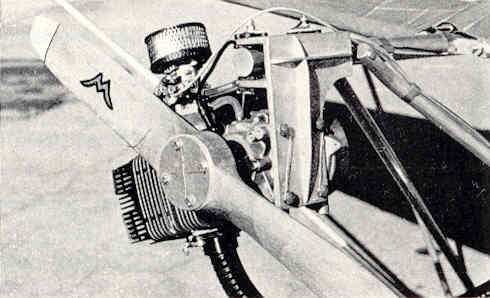
Yamaha engine details
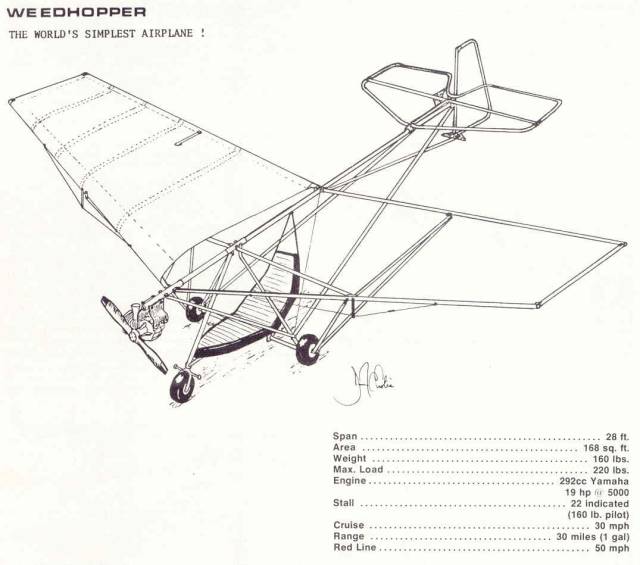
|
